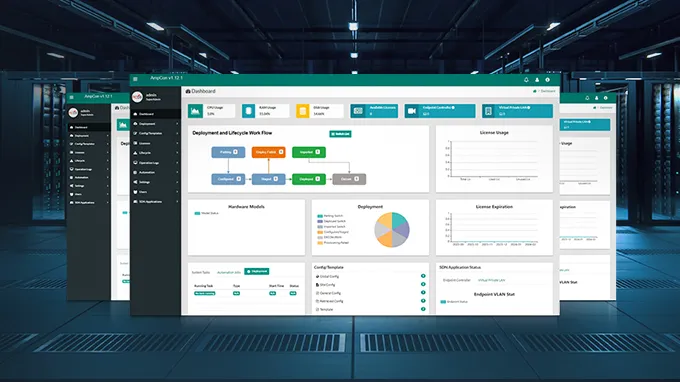PAM4 vs. Coherent Optics: which is better for 100G DWDM?
With the increasing demand for high-speed network applications such as 5G, cloud computing, and storage networks, optical transmission networks are also evolving rapidly. And 100G DWDM solutions have gradually improved and matured. The 100G PAM4 modules and CFP2 coherent modules are the most popular for 100G DWDM network transmissions. Direct modulation and coherent technology can easily extend the transmission distance up to 80km or even 1000km for metro and DWDM networks. So, what is the difference between these two technologies? Which one is more suitable for 100G DWDM transmission? I believe you will find the answer after reading this article.
100G PAM4 QSFP28 vs. Coherent Optics
Coherent CFP/CFP2 transceivers are different from PAM4 QSFP28 modules in some respects. However, they do have some similarities when it comes to 100G network applications.
What Is PAM4 Module?
QSFP28 PAM4 is a technology encoding two bits of data with four distinct signal levels. Previously, the traditional binary NRZ modulation format was used for 40G and 100G long-haul transmission. With four patterns to encode two data bits, the PAM4 modules double the bandwidth of the connection with each signal level representing 2 bits of logic information. It plays a key role in multi-order modulation and makes PAM4 the most efficient and cost-effective enabler of 100G DWDM solutions.
Typically, the common types of PAM4 technology are 50G(1*50G PAM4), 200G(4*50G PAM4), and 400G(8*50G/4*100G PAM4).100G PAM4 QSFP28 transceivers adopt PAM4 modulation technology to achieve high-speed signal transmission and the construction of 100G in large data centers, campuses, and enterprise networks.
Figure 1: 100G PAM4 Signaling Technology
What Is Coherent Technology and Optics?
Coherent technology uses amplitude, phase, and polarization of light to focus more data on the wave that is being transmitted. Thus, much higher bitrates can be achieved on a single wavelength by the adoption of DSP (Digital Signal Processor). CFP DCO (Digital Coherent Optic), CFP2 coherent ACO (Analog Coherent Optic), CFP2 coherent DCO are the common types of transceivers that use coherent technology to achieve 100G DWDM transmission.
-
CFP DCO: It has an integrated digital signal processing chip (DSP), which means it can improve amplification and receiving sensitivity without a separate DSP and dispersion compensation module (DCM). Besides, the CFP DCO is also equipped with electronic dispersion compensation (EDC), which can realize data transmission beyond 100km.
-
CFP2 ACO: The width of CFP2 ACO is half of the CFP. It needs a dedicated DSP on the host board because today's CFP2 DWDM transceivers are analog. Therefore, it adds extra power consumption and cost to the mainboard to some degree.
-
100G CFP2 DCO: Different from the CFP2 ACO, CFP2 DCO has an integrated DSP ASIC, but it is also more expensive. Besides, it can meet the requirements of vendors using CFP2 without DSP and also support better wavelength utilization.

Figure 2: Coherent Optics Working Principle in DWDM Solution
Differences between 100G PAM4 QSFP28 and Coherent Optics
Bandwidth Efficiency
-
PAM4: PAM4 is less bandwidth-efficient compared to coherent optics. It uses four amplitude levels to encode data, allowing twice the data rate within the same bandwidth as traditional NRZ (Non-Return to Zero) modulation. However, it requires more signal processing and error correction techniques to compensate for its lower signal-to-noise ratio.
-
Coherent Optics: Coherent optics can achieve higher spectral efficiency by leveraging the phase and amplitude of the optical signal. It allows for higher-order modulation formats, such as QPSK (Quadrature Phase Shift Keying) or 16-QAM (Quadrature Amplitude Modulation), which can transmit more bits per symbol compared to PAM4.
Reach and Fiber Impairments
-
Coherent Optics: Coherent optics is better suited for longer-distance transmission and overcoming fiber impairments such as chromatic dispersion and polarization mode dispersion. Its coherent detection allows for sophisticated digital signal processing techniques like digital signal equalization and adaptive modulation, enhancing signal quality over long-haul links.
-
PAM4: PAM4 is more sensitive to fiber impairments, limiting its reach compared to coherent optics. It may require additional signal regeneration or amplification for longer-distance transmission.
Cost and Complexity
-
PAM4: PAM4 transceivers tend to be simpler and less expensive compared to coherent optics. They require less sophisticated signal processing and are more widely deployed in shorter-reach applications, such as data center interconnects.
-
Coherent Optics: Coherent optics transceivers are more complex and expensive due to the need for coherent detection and advanced digital signal processing capabilities. However, their higher spectral efficiency and longer reach make them suitable for high-capacity, long-haul DWDM networks.
Power Consumption
-
PAM4: PAM4 transceivers typically consume less power compared to coherent optics, making them more suitable for power-sensitive applications like data centers.
-
Coherent Optics: Coherent optics modules consume more power due to the additional digital signal processing required for coherent detection and modulation.
Conclusion
To sum up, both PAM4 modules and coherent optics work effectively in 100G DWDM network transmission. Differently, the 100G PAM4 optical transceivers are more cost-efficient and suitable for transmission below 80km, while the 100G coherent optics are better choices for transmission beyond 100km, but it also has limitations on equipment. Data centers and enterprises can choose any combination of optical modules according to their specific requirements.
You might be interested in
Email Address

-
PoE vs PoE+ vs PoE++ Switch: How to Choose?
May 30, 2024













